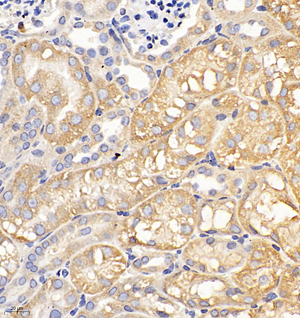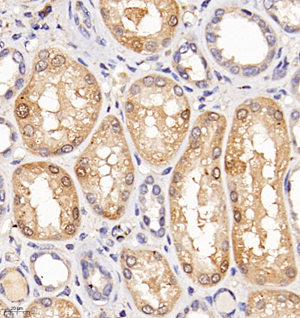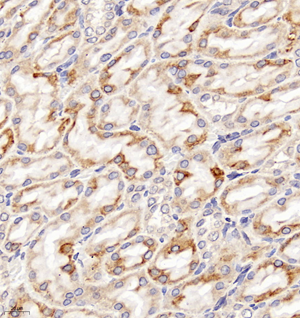Anti-ClC-5 Rabbit pAb (100 μl)
| Reactivity: | H,M,R |
| Applications: | IHC/IF |
| Host Species: | Rabbit |
| Clonality: | Polyclonal |
| Full Name: | ClC-5 rabbit polyclonal antibody |
Gene Name: | H(+)/Cl(-) exchange transporter 5 |
Synonyms: | Chloride channel protein 5, ClC-5, Chloride transporter ClC-5, Clcn5, Clc5, Voltage gated chloride ion channel CLCN5, NPHL1 |
Immunogen: | KLH conjugated Synthetic peptide corresponding to Mouse ClC-5 |
Isotype: | IgG |
Purity: | Affinity purification |
Subcellular location: | Golgi apparatus, Endosome, Cell membrane |
Uniprot ID: | Q9WVD4, P51796 |
Product Usage Information
Applications | Species | Dilution | Positive Sample |
IHC/IF | Human, Mouse, Rat | 1: 100-1: 400 | kidney |
Background
The family of voltage-dependent chloride channels (CLCs) regulate cellular trafficking of chloride ions, a critical component of all living cells. CLCs regulate excitability in muscle and nerve cells, aid in organic solute transport and maintain cellular volume.Mutations in the gene encoding CLC1 lead to myotonia, an inheritable disorder characterized by muscle stiffness and renal salt wasting. CLC2 is highly expressed in the epithelia of several organs including lung, which suggests CLC2 may be a possible therapeutic target for cystic fibrosis. CLC3 expression is particularly abundant in neuronal tissue, while CLC4 expression is evident in skeletal and cardiac muscle as well as brain. Mutations in the gene encoding CLC5 lead to Dent’s disease, a renal disorder characterized by proteinuria and hypercalciuria.
Images
| Immunohistochemistry of paraffin embedded human kidney using Clcn5 (GB112387) at dilution of 1:200 (400x lens) |
 | Immunohistochemistry of paraffin embedded mouse kidney using Clcn5 (GB112387) at dilution of 1:200 (400x lens) |
| Immunohistochemistry of paraffin embedded rat kidney using Clcn5 (GB112387) at dilution of 1:200 (400x lens) |
Storage
| Storage | Store at -20°C for one year. Avoid repeated freeze/thaw cycles. |
| Storage Buffer | PBS with 0.02%sodium azide,100 μg/ml BSA and 50% glycerol. |





